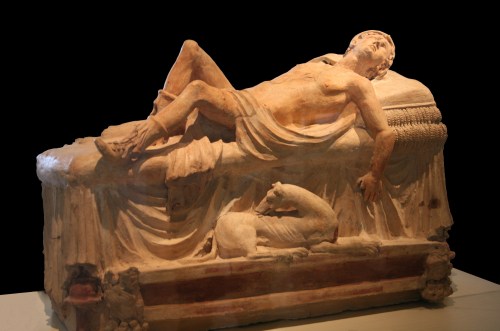The Lamentations for Tammuz
“On the one hand, we now know who was that Tammuz in whose honour Ezekiel saw the women of Jerusalem weeping at the gate of “the Lord’s house.”
On the other hand, it is clear that the Tammuz and Istar of the Babylonian legend are the Adonis and Aphrodite of Greek mythology. Like Tammuz, Adonis, the beloved one of Aphrodite, is slain by the boar’s tusk of winter, but eventually ransomed from Hades by the prayers of the goddess.
It has long been recognised that Aphrodite, the Kyprian goddess of love and war, came to Hellas from Phoenicia, whether or not we agree with Dr. Hommel in seeing in her name a mere etymological perversion of the Phoenician Ashtoreth.
Adonis is the Phoenician Adoni, “my lord,” the cry with which the worshippers of the stricken Sun-god mourned his untimely descent into the lower world.
The cry was familiar throughout the land of Palestine. In the valley of Megiddo, by the plain of Jezreel, each year witnessed “the mourning for Hadad-Rimmon” (Zechariah xii. ll),while hard by Amos heard the men of Israel mourning for “the only son” (Amos viii. lo), and the prophet of Judah gives the very words of the refrain: “Ah me, my brother, and ah me, my sister! Ah me, Adonis, and ah me, his lady!” (Jeremiah xxii. 18).

Monument funéraire, Adonis mourant: Museu Gregoriano Etrusco, Vatican.
Uploaded by Jean-Pol GRANDMONT
http://en.wikipedia.org/wiki/Adonis#/media/File:0_Monument_funéraire_-_Adonis_mourant_-_Museu_Gregoriano_Etrusco.JPG
The words were carried across the western sea to men of an alien race and language. “Cry ailinon, ailinon! woe!” says the Greek poet of Athens, and already in Homeric days the dirge was attributed to a mythic Linos whose magic fate was commemorated in its opening words: “0 Linos, Linos!”
Linos, however, had no existence except in a popular etymology; the Greek ailinos is in reality the Phoenician ai-lénu, “alas for us!” with which the lamentations for the death of the divine Adonis were wont to begin.
Like the refrain quoted by Jeremiah, the words eventually go back to Babylonia, and find their counterpart in the closing lines of the old Babylonian poem I have translated above. When Tillili commences her wail over the dead Tammuz, she cries, like the women of Judah and Phoenicia, “0 my brother, the only one!”
It was, above all, in the Phoenician town of Gebal or Byblos that the death of Adonis was commemorated. Here, eight miles to the north of Beyrût, the ancient military road led from eastern Asia to the shores of the Mediterranean, and brought from early days the invading armies of Babylonia and Assyria to the coasts and cities of Canaan.
Hard by was the river of Adonis, the Nahr Ibrahim of to-day, which rolled through a rocky gorge into the sea. Each year, when the rains and melting snow of spring stained its waters with the red marl of the mountains, the people of Gebal beheld in it the blood of the slaughtered Sun-god.
It was then, in the month of Tammuz or June, that the funeral-festival of the god was held. For seven days it lasted. “Gardens of Adonis,” as they were called, were planted, pots filled with earth and cut herbs, which soon withered away in the fierce heat of the summer sun–fitting emblems of the lost Adonis himself.
Meanwhile, the streets and gates of the temples were filled with throngs of wailing women. They tore their hair, they disfigured the face, they cut the breast with sharp knives, in token of the agony of their grief.
Their cry of lamentation went up to Heaven mingled with that of the Galli, the emasculated priests of Ashtoreth, who shared with them their festival of woe over her murdered bridegroom.
Adonis, the young, the beautiful, the beloved of Ashtoreth, was dead; the bright sun of the springtide, like the verdure of nature which he had called into life, was slain and withered by the hot blasts of the summer.”
A.H. Sayce, Lectures on the Origin and Growth of Religion as Illustrated by the Religion of the Ancient Babylonians, 5th ed., London, 1898, pp. 227-9.
